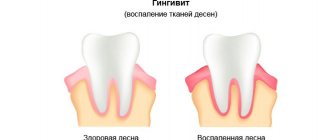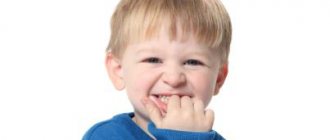Most often, parents are the first to notice asymmetry: while changing clothes, bathing or playing with the baby, it is noticeable that the baby’s folds are unevenly distributed. Suspicions immediately arise that one leg is shorter.
Situations like this are not uncommon. They can indicate both true and false shortening.
Causes of pathology if one leg is shorter than the other
The diagnosis can only be made if the difference is at least ½ cm. When the bones of one leg are shorter than the other, true shortening occurs. The reasons for this are hidden in the underdevelopment of bone tissue, that is, in developmental anomalies; as a result of purulent-inflammatory diseases of the hip joint.
Pathology in children under 8 months of age is eliminated through splints, massage, and staged plaster casts. Further therapy depends on the diagnosis, but most often it is necessary to perform surgery.
Dysplasia
In this case, false shortening occurs when the bones are the same in length, but one limb stretches upward.
In children of the first year of life this most often happens due to:
- hip dysplasia;
- partial/complete subluxation, hip dislocation.
The doctor determines the pathology, as they say, “by eye.” Difficulties in diagnosis arise in the first 2 months of life. It is easier to detect a unilateral dislocation at the age of 3-4 months.
- Treatment up to 9 months of age involves manual massage to correct the pelvic bones.
- Older children take longer to be treated and may need to wear a special splint.
- Dysplasia goes away after physiotherapy, massage and exercise therapy.
If left untreated, the pathology will progress.
- Parents should not swaddle their baby tightly;
- Forcefully straighten limbs;
- Get back on your feet ahead of schedule;
- Avoid vertical loads, as there is a risk of worsening joint deformation.
Hip dislocation
- Congenital pathology is eliminated by gradual reduction and plaster casts or splints.
- The duration of therapy is individual, ranging from several months to a year. The treatment complex includes manual therapy: selective, acupressure, special exercises.
- The pregnancy calendar allows you to find out how the baby should develop; accordingly, the expectant mother can find out about the congenital disorder through an ultrasound scan and begin treating the baby immediately after his birth.
Manual therapy is resorted to some time after reduction. The chiropractor must strengthen the weakened muscular system and prevent degenerative changes in joint tissue. After removing the bandage, they strengthen the muscles that were weakened during its use, and also prepare the joints for the upcoming loads.
Treatment of congenital dislocation is most effective in the first 3 months of life. When the child is much older, surgery has to be performed.
Muscle hypertonicity
The reasons for false shortening may be hidden in the increased tone of one limb. This is noticeable after six months of age.
In turn, hypertension provokes:
- increased intracranial pressure;
- fetal hypoxia;
- anemia of the brain.
This condition is often observed in babies born during traumatic birth and asphyxia.
Pathology can be suspected when the baby lies in the fetal position in the first months of life, the arms are bent in all joints, pressed to the body, the legs are bent, slightly moved to the sides, the head is thrown back.
Parents can separate the limbs several times; if there is no resistance, then the tone is normal.
When a child stands on tiptoes with support and curls his fingers, a consultation with a neurologist is needed. The child needs exercise and possibly medication.
Causes of constipation in infants and children under 7 years of age
Due to the anatomical and physiological imperfections of the digestive system and the influence of numerous risk factors, a single cause of the disease has not been established. Constipation in a child is a complex, polyetiological disease that has individual mechanisms of development and manifestation. The impact of risk factors and a number of other circumstances lead to a slowdown in the propulsive activity of the intestine, the accumulation of dense masses in the distal sections, and the appearance of characteristic symptoms of the pathology.
Main predisposing factors
| Prenatal | Intrapartum | Postnatal |
|
|
|
Dominant causes of constipation
Nutritional reasons
These include the following factors:
- nutritional disorders and indiscriminate feeding;
- underestimation of the baby’s individual food preferences, frequent changes of formulas;
- forced and excessive feeding (“to the last drop”);
- introducing into the diet foods that a child of this age cannot adequately digest;
- early introduction of complementary foods and transition to solid foods;
- selective nutrition (deficiency of dietary fiber, imbalance between food ingredients);
- disordered eating pattern (disordered and episodic eating).
Social and psychological reasons
These include the following factors:
- low physical activity, tight swaddling, use of diapers with tight straps, etc.;
- “potty phobia” syndrome;
- pedagogical errors in education;
- psychological depression, increased shyness;
- unformed stereotype of defecation;
- low stress resistance and lability of the child’s character.
Pathological conditions of the body
This includes the following:
- organic intestinal diseases (Hirschsprung's disease, dolichocolon and dolichosigma (elongation of intestinal sections), anal fissures, hemorrhoids;
- iron deficiency;
- rickets;
- neurological diseases (myopathies, paresis, paralysis of various origins);
- in girls, inflammatory processes of the internal genital organs;
- endocrine and metabolic diseases (diabetes mellitus, hypothyroidism, cystic fibrosis).
Use of certain groups of medications
These include:
- codeine and its derivatives;
- sedatives (phenobarbital, antidepressants, phenothiazine derivatives);
- Loperamide;
- enterosorbents;
- antacids, etc.
When the legs are different: normal options
Minor deviations generally do not indicate pathology. There is such a thing as physiological shortening of the lower limb. For example, shortening of the right leg is often observed in children with severe left-handedness and vice versa.
In order for a baby to grow and develop well, he must be physically active. Jumping, running, movements lead to the fact that one limb becomes the leading, pushing one, that is, it bears a greater load than the other. That's why the push leg is a little shorter. A stronger limb develops faster. Later this difference will disappear.
Main manifestations
In infants with delayed bowel movements, visible changes are minimal. With prolonged intestinal dysfunction, it is possible to detect an increase in the size of the abdomen due to the accumulation of feces in the distal parts of the gastrointestinal tract. Children complain of a feeling of awkwardness, fullness and distension in the abdomen, especially on the left side.
When dense and fused fecal masses are expelled, the patient experiences sharp pain in the anal area, which is caused by the appearance of tears and cracks. The child subsequently does not dare to defecate, accompanied by painful sensations, begins to spontaneously delay bowel movements, resulting in prolonged constipation, and sometimes the reflex to defecate is lost.
How to independently determine which leg is shorter than the other
You can detect the violation at home, without much experience.
Parents may well do some of the testing themselves.
- It is necessary to position the baby correctly before the examination. Optimally - on the table surface. The latter needs to be covered with a diaper or blanket, but so that the baby does not “drown” in soft blankets;
- You need to choose the right time. It is often difficult to put children to bed without interference, because they do not understand at all what is wanted from them;
- The baby should be placed belly down. You can stroke his back to relax his muscles. Then he is turned over on his back. You need to pay attention to whether he is comfortable in this position. You need to let him grab your fingers. If the baby actively grabs, tries to pull himself up, moves rhythmically, and automatically moves his limbs symmetrically and in full, then the child is healthy. With increased muscle tone, its legs will cross;
- Next, you need to pay attention to the restrictions in spreading the limbs: you need to bend your legs at the knees and hips, and then carefully spread them apart. If you have dysplasia, this will not be possible;
- Dysplasia can be diagnosed by placing the baby on its stomach. You need to bend his legs, as when crawling. In this position, pronounced pathology will be noticeable. Parents should pay attention to whether the folds of skin on the thighs are symmetrical and whether there is a difference in the length of the limbs. It is worth conducting such a study several times a day;
- If the baby is older than six months, you need to examine his body for asymmetry, and also examine the symmetry of the joints;
- In children older than one year, the symmetry of the muscles of the lower extremities is checked. If one of them is thinner in volume (in the thigh and lower leg), it means that it is subject to less stress.
If you have any doubts, you should definitely tell your doctor about them, for example, a pediatric surgeon or orthopedist, or a neurologist. Based on the cause of the pathology, treatment will be selected.
How to help a child with constipation
Treatment of constipation in children is a rather complex and lengthy task.
Changing your diet
Dietary changes, such as increasing fluid and carbohydrate intake, are usually recommended as part of the treatment for constipation.
Balanced diet
Poorly absorbed sugars (eg sorbitol) are found in many fruit juices (eg prune, pear, apple). These sugars increase the frequency of bowel movements. If your child is constipated, it is recommended to eat a balanced diet that includes whole grains, fruits, vegetables and plenty of fluids.
Elimination of cow's milk
Cow's milk protein should be eliminated from the diet of infants and young children for a period of time as it aggravates chronic constipation.
Unnecessary or ineffective dietary changes
There is no need to switch your baby to low-iron formula. Several studies have shown that consuming iron-rich formulas is not associated with constipation.
There is also no reliable evidence that the use of probiotics is effective in treating constipation in adults and children.
Increased physical activity
For adults and children, daily exercise will help with digestion and relieve constipation.
Regular physical activity helps food move quickly through the colon and helps the intestinal muscles contract, moving waste around.
On the other hand, inactivity leads to weak bowels, making it difficult to pass feces regularly.
One of the best exercises for children is walking. Take 30 minutes a day to walk, especially after meals.
Swimming and cycling on a regular basis will also be beneficial.
Drug therapy. The main groups of drugs for the treatment of constipation in children
The mainstay of pharmacological therapy for constipation is the use of sufficient laxatives to achieve the desired effect. Continuous use of laxatives may be necessary for several months until the association between bowel movements and pain disappears.
Osmotic laxatives:
- polyethylene glycol;
- magnesium hydroxide;
- lactulose;
- sorbitol;
- magnesium citrate;
- sodium phosphate.
The drugs help attract water from the cells, which leads to expansion of the intestines and increased peristalsis.
Laxatives with a stimulating effect:
- Sennoside;
- Bisacodyl.
Drugs in this group enhance peristaltic activity in the gastrointestinal tract. Most of these agents also stimulate the release of salt and water in the colon.
Stool softeners:
- docusate sodium.
The drug saturates the stool with water and fat, helping to soften it.
ethnoscience
Early research suggests that drinking herbal teas made from fennel, anise, elderberry and senna daily for 5 days may reduce constipation.
Fennel seeds stimulate muscle movement in the digestive tract, which leads to healthy digestion and regular bowel movements. Fennel seeds also prevent gas in children.
The use of a cleansing enema for constipation in children
In some cases, an enema can be used to help relieve constipation. However, this should only be done on the advice of a doctor.
This method should not be used constantly, since regular use of an enema can prevent the intestinal muscles from properly doing their job of removing feces.
It is also possible to develop an electrolyte imbalance, which will require additional treatment.
Consequences for the baby if one leg is shorter than the other
Many people mistakenly think that different limb lengths will necessarily lead to lameness. It is not always so.
- In the child's body, if the pathology is not treated, metamorphosis will occur: the existing defect will be compensated by tilting the pelvis towards shortening.
- In the future, such a condition will lead to curvature of the spinal column, the consequences are no less serious than dystrophic changes in the joints.
- As a result, the spine will bend in the form of the Latin letters “S” or “C”, one shoulder will also bend towards the affected limb.
Preventing constipation in a child
- Children should be offered foods high in fiber, such as fruits, vegetables, beans, whole grain cereals and breads. If your child is not used to a high fiber diet, you can start by adding a few grams of fiber to their food daily to help prevent gas and bloating.
- The child should be encouraged to drink plenty of fluids.
- Regular physical activity stimulates intestinal motility.
- Going to the toilet should be comfortable for the child. You can provide your baby with a footstool so that he has enough support to have a comfortable bowel movement.
- It is important to remind your child to never ignore the urge to defecate.











